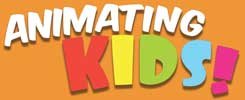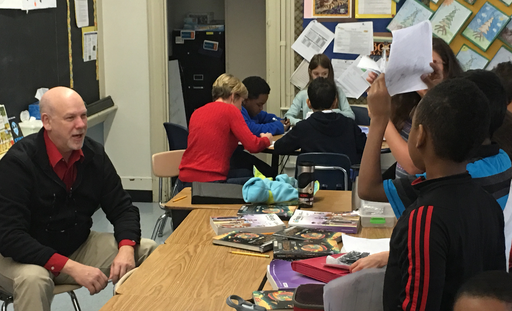Note to Educators: One of the biggest bottlenecks in filmmaking is editing. Even though films are made by large teams, editing is usually handled by just one or two people working alone in post-production. Our approach flips that. To keep kids collaborating from start to finish, we front-load the planning. That’s why storyboarding is essential — it helps the group make creative decisions early and avoids hours of solo editing later. So when Joe asks the class to pull out their storyboards, that’s the reason: we’re pre-editing on purpose — to stay a dynamic, creative team all the way through.
Young cinematographers stand and deliver their stories.
Where Art Meets Cinematography
Joe begins, “Okay. Now that you've timed out your movie and sequenced your scenes, it's time to tighten things up a bit. Get out your storyboards.”
The room fills with the sounds of shuffling papers, rustling supplies, and students grouping together.
“I’m going to describe the steps for today,” Joe continues. “This is mostly a pre-production day. It’s also the moment where the artists finally get to make things pretty and artistic,” he adds with a grin.
“This scribbly mess we call a stick-figure storyboard? That’s our blueprint. Don’t lose it. It’s going to be part of every session from here on out. Today, we’re going to create big, beautiful, color illustrations of each storyboard scene.”
Each group has a box of crayons, colored pencils, markers, and blank 8x11 sheets of white paper at the ready.
“Before you get started,” Joe says with a spark in his eye, “I’m going to change the way you look at movies forever.”
He walks around the room, passing out three printed worksheets.
“These worksheets will help you become the cinematographers we need you to be.”
Joe pauses for effect.
“As a filmmaker, you need to understand that where you place the camera matters. The camera is actually a character in your film.”
“For the audience, the camera is their point of view — their POV — and the movie streams straight into their brainstem from this perspective, right next to where their dreams live,” Joe explains. “We don’t think much about camera position when we watch a movie...”
“But!” Joe continues, now pacing a little, “when we make a movie, camera position takes very careful planning. These basic ideas on your worksheets? Hollywood’s been perfecting them for over 100 years.”
“If we do it right, where we place the camera will have as much impact on how our audience feels as anything our characters say or do.”
Joe turns to the board.
“We break our planning into three basic options,” he says as he writes:
Long Shot
Medium Shot
Close-Up
“Let’s review each one.”
“Long shots are used when you want to give your audience a clear sense of the setting — or show differences in size,” Joe explains, pointing to the worksheet labeled Long Shots.
“For example, in our turtle movie, we might start with a long shot of the baby turtle alone on a frozen lake. That helps the audience feel how small, lost, and lonely it is in such a big, empty space.”
He pauses, then adds, “If you were using a real camera, you'd have to back up a long way to fit the entire lake in the frame.”
“Medium shots are best for showing your character on screen, doing something,” Joe explains.
“If you have a scene with two characters talking, or a moment where someone’s striking a cool pose or showing off a costume, this is your go-to shot. You want the camera close enough that the character fills the frame — not too far away, not too close.”
He adds, “In our rocket movie, for example, if a boy is sneaking into a spaceship, give us a great medium shot that shows his whole body in that sneak-walking pose. Let the audience feel what he’s doing.”
“Close-ups,” Joe continues, “are probably the shot you’re most familiar with — but what matters is how we use them.”
“If your characters are showing big emotions — laughing, crying, or anything in between — get in close. Let those emotions fill the screen. The closer we are, the more your audience will feel it.”
He pauses, then adds, “Close-ups are also great for small but important details. In our diaper movie, we start with a close-up of a phone screen. Why? Because the audience needs to read the text message to understand the whole story. A close-up makes sure nothing important gets missed.”
“Using your storyboard as a blueprint,” Joe says, “let’s apply these shot choices to each scene as we recreate them in living color.”
He continues, “By the time every scene is illustrated, you’ll have decided on camera positions and started designing your characters and costumes.”
Then he grins, “Once that’s done, each group will present your story to the class — a full-color show and tell.”
For the rest of the session, Joe floats between groups, offering feedback on shot selection, character design, and color choices. Not every team finishes their drawings, so presentations will kick off next time.
Before the bell rings, Joe pauses at the door.
“Oh — you have homework.”
Groans ripple through the class.
“I told you this would change the way you see media,” Joe says. “I want you to notice how scenes shift between Close-Ups, Medium Shots, and Long Shots in anything you watch. Pay attention to how often the camera moves, and why it’s placed where it is.”
“These brilliant people called cinematographers work closely with directors to make those choices. But in your movies — you’re playing every role. So start noticing. It matters.”
He gives a final wave. “Goodbye!”
Who is this Joe fellow?
Meet Joe Summerhays: The Storyteller Who Makes Classrooms Cinematic
Joe Summerhays is the creative force behind Animating Kids, the globally adopted media literacy platform that turns traditional learning environs into movie studios and students into visual storytellers. With over 25,000 kids and educators trained across 20+ countries, Joe has redefined what it means to be literate in the 21st century — reimagining stop motion animation, storytelling, and digital production into a media making skill set for the next generation.
An award-winning creative executive in software, TV, publishing, and advertising, Joe brings a seasoned eye and playful spirit to education. Through his signature colored Animation Chef Hat Levels (inspired by karate belts), students and teachers alike progress from animation basics to full-on film production — all while hitting ISTE, AASL, and P21 standards for digital fluency and creative communication.
Animating Kids isn’t just a curriculum — it’s a movement. A toolkit for schools. A legacy for media coaches and tech specialists. And it all flows from Joe’s belief:
Media skills literacy is the new reading and writing for the Tiktok/Youtube generation.






















